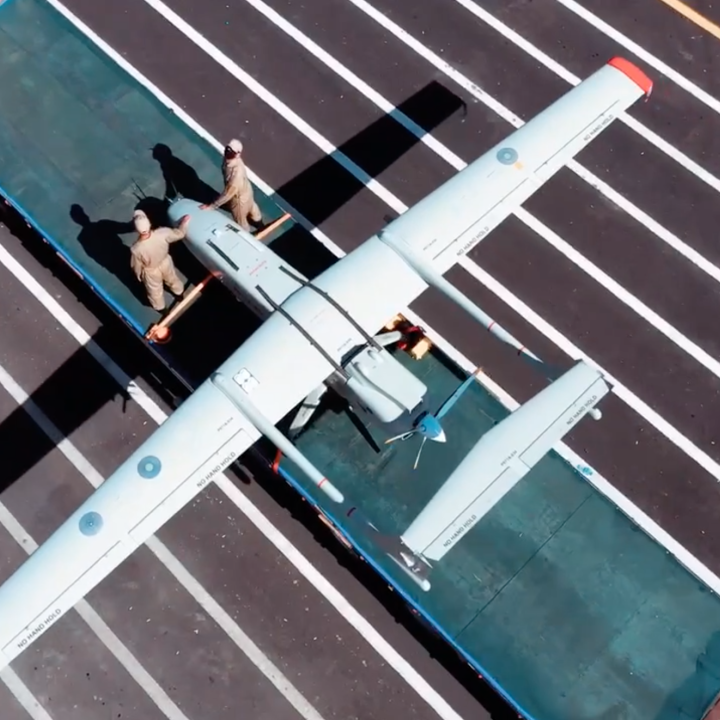
Kataib Hezbollah Leads Drone Warfare Inside Iraq

The group is employing sophisticated drone capabilities against U.S. airbases in Iraq, mirroring tactics and systems used in Yemen.
Although Asaib Ahl al-Haq (AAH) initially drove indirect fire attacks on U.S. facilities in November-December 2020 and February 2021, Kataib Hezbollah (KH) has belatedly joined the party. On March 7, 2021, Militia Spotlight noted that KH was quickly shifting its rhetoric from truces to a new phase of conflict with U.S. forces in Iraq. This shift is now being operationalized into drone attacks.
The first indicator came on March 3, when KH launched rockets against al-Asad Air Base (Figures 1 and 2), which led to the death of one American civilian contractor but did not draw U.S. retaliation. Afterward, the KH-controlled Unit 10,000 propaganda channel posted, “The equation has changed. Political mediation will not work...This is a new transformation in confronting [the enemy].” Two months later, there are many indicators that KH has concluded from the March 3 incident that it can safely test Washington's response threshold, though it has avoided causing further U.S. fatalities so far.
Via its facade group Qasem al-Jabbarin (QJ), KH has continued to mount roadside bombings on Iraqi supply trucks serving the coalition, a method that carries no risk of U.S. casualties and (demonstrably) no risk of U.S. retaliation. QJ has claimed at least thirteen such bombings since March 3, with another thirteen claimed by AAH facades Ashab al-Kahf and Saraya Awliya al-Dam. Although the groups sometimes disseminate photo and video evidence of these attacks, many of the claims are unverified. Of note, QJ convoy attacks have demonstrated a special focus on disrupting coalition transfer of border control materiel to Anbar, where KH is keen to keep Iraq’s security forces away from its frontier with Abu Kamal and al-Tanf in Syria.
In parallel to these convoy attacks, KH has returned to undertaking indirect fire attacks (drones and rockets) on U.S. points of presence, something it had ceased during its self-declared truce with U.S. forces, announced on October 10, 2020. Rockets were fired against al-Asad and (unusually for KH) Balad on May 3 (pre-attack images of the Balad rockets were unveiled as “exclusives” by KH media channels, see Figure 3). In addition, the period since March 3 has been marked by a rash of unprecedented drone attacks within Iraq:
- March 4, 2021: Iraqi government and Kurdistan Region leadership locations were closely overflown by unknown drones in apparent intimidation operations. Of note, no group claimed either incident—in keeping with an apparent shift in militia media strategy—but the incidents are acknowledged within Iraqi and Kurdish government circles.
- April 14, 2021: A fixed-wing drone struck a coalition hangar at Erbil Airport.
- April 28, 2021: Militia propaganda channels claimed that coalition locations at Balad base were struck by a drone. On May 15, the Liwa al-Khaiber facade group (which first appeared on March 17) claimed the attack with a video posted to its Telegram account purporting to show the launch. The following day, Sabereen News reposted the video with a [now-deleted] post claiming "Sabereen News alone reported the news on 28/4 about the targeting of the American military wing at the Balad base, specifically the Lockheed Martin company, using a drone."
- May 8, 2021: A hangar at al-Asad Air Base was struck by a drone.
- Other airbase locations may also have been struck by drones in May.
Previously, Yemen’s Houthi rebels developed an aggressive campaign of attacking Saudi aircraft hangars, and KH may be embarking on a similar program in Iraq. Based on imagery and descriptions of a wrecked drone from Erbil (Figure 4), Iraqi militias are now fielding a twelve-foot wingspan drone similar to the Sammad-1, an Iranian-designed aircraft with a range of 300 miles/500 km, used by both the Houthis and Lebanese Hezbollah.
Of note, the Houthis rapidly moved from fielding these simple drones to using longer-range Sammad-3 systems (750-930 miles/1,200-1,500 km) in 2018-2019, suggesting that Iranian-backed Iraqi groups could easily make a similar leap. KH facade Alwiyat al-Waad al-Haq already claimed a drone strike on Riyadh on January 23, 2021, at a range of about 650 miles/950 km. KH has also been documented assisting Iran's Islamic Revolutionary Guard Corps (IRGC) in launching drones from Iraq into Saudi Arabia on at least one occasion (May 14, 2019).
Since KH announced that “the equation has changed,” an unknown militia operator has commenced the unprecedented use of accurate drone systems inside Iraq and used them against a range of enemies domestic and foreign. That operator has experienced no retaliation, largely because they have chosen—thus far—not to kill Americans with these systems.
A preponderance of the evidence suggests that KH is the drone operator, due to its uniquely close relationship with known foreign operators of this type of system: the IRGC and Lebanese Hezbollah. As noted above, KH helped the IRGC launch drones into Saudi territory on May 14, 2019, and KH facade Alwiyat al-Waad al-Haq has claimed drone strikes outside Iraq’s borders at ranges of 650 miles/950 km. If and when U.S. personnel are killed by new drone systems in Iraq, quick attribution should not be particularly challenging.










